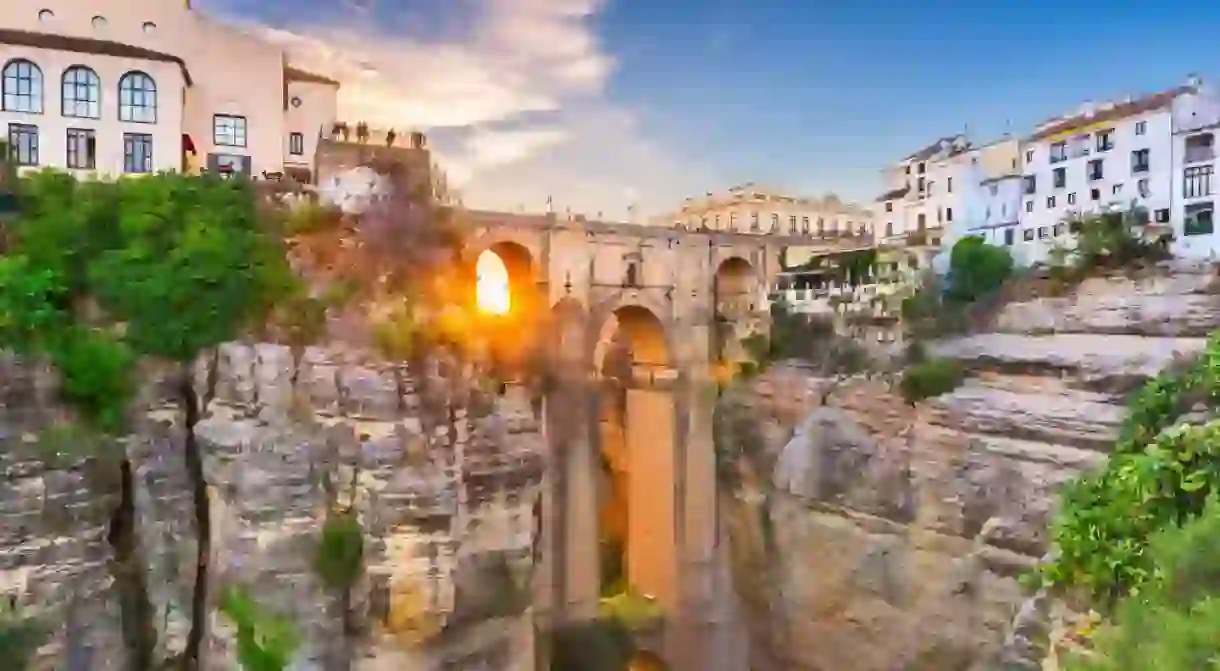How to Spend the Perfect 48 Hours in Ronda

A two-day trip to Ronda will enable you to take in all it has to offer, from the dramatic El Tajo gorge to one of Spain’s most historic and beautiful bullrings. Read on for our guide to spending 48 hours in this enchanting Andalusian town.
Day 1, Morning
Bridges
Ronda’s main attraction is an acrophobe’s worst nightmare. The dizzying, 120-metre-high (394 foot) Puente Nuevo (‘New Bridge’) was finished in 1793 and spans the El Tajo gorge that divides Ronda in two. Make sure it’s the first thing you see after arriving here and, if you’re up to it, stand in the middle and look straight down through the iron grilles set into the stone.
A little further down the river that runs through El Tajo are two older and smaller bridges that are well worth a visit. The first you come to is the so called Puente Viejo, or ‘Old Bridge’, which dates from the early 17th century; and the second, known as the Puente San Miguel, was built by the Moors between the 8th and 15th centuries. It was to improve upon both of these crossings that the New Bridge was conceived.

Discover the beauty of Andalusia with a day trip to Ronda and Setenil de las Bodegas. Visit Ronda’s historic bullring, the Plaza de Toros, and marvel at the stunning views from the Puente Nuevo bridge. In Setenil, explore the unique houses built into the rock and enjoy the charming streets of this picturesque village. This tour offers a perfect blend of history, culture, and natural beauty.
El Tajo
Spend the rest of your first morning in Ronda walking in El Tajo. There are plenty of paths that zigzag down into the gorge, but the best starts in Plaza María Auxiliadora in the old Moorish quarter. This undemanding yet dramatic route takes you right down to the bottom of the canyon, from where you are given a whole new perspective on the magnificent Puente Nuevo. Allow a good hour and a half for the round trip.
Afternoon
Bandits Museum
After a hearty lunch (try La Alacena in the newer part of town), head to Ronda’s quirky Museo del Bandoleros (‘Bandits Museum’), the only museum of its kind in Spain. Throughout the 19th century and even as late as the 1930s, it was almost impossible for travellers approaching Ronda to avoid being robbed by bandits. The museum offers a fascinating insight into this aspect of the town’s history.
Old Town
Emerging from the Bandits Museum, you’re ideally-placed to finish off the afternoon exploring the oldest and most beautiful part of Ronda. Known simply as La Ciudad (‘The Town’), this quarter dates from Ronda’s period under Moorish rule, which lasted from the 8th to the late 15th centuries, and abounds in gorgeous Mudejar-style buildings, romantic squares and winding little streets. Among them, you’re bound to find a great spot for drinks and dinner.

Explore Ronda on a walking tour that delves into its rich history and cultural significance. Visit key sites such as the Plaza de Toros, the Puente Nuevo, and the historic old town. Learn about Ronda’s bullfighting traditions and its role in Spanish history from a knowledgeable guide. This tour provides an immersive experience of one of Spain’s most beautiful and historic towns.
Day 2, Morning
Bullring
Ronda is the birthplace of the modern Spanish bullfight, so no visit here would be complete without learning about the world of the bulls. Kick off your second morning by heading to the town’s elegant 18th-century plaza de toros, itself one of the most beautiful sights in Ronda. You can visit all parts of the bullring, including the torriles where the bulls are kept before the bullfight and the dark, narrow tunnel which takes them out into the arena. The ring also houses a superb bullfighting museum, which looks at Ronda’s deep connection with this controversial spectacle.

Arabic Baths
After learning about the bulls, wander in the direction of the Puente Viejo to visit the town’s Baños Arabes, or Arabic Baths. Dating from the 10th and 11th centuries, these are some of the best preserved such buildings in Spain; bathers chose between three rooms, which maintained cold, warm and hot temperatures, and received light and fresh air from star-shaped holes in the ceilings. Though the functional parts are long gone, the interiors are just as beautiful as they were almost a thousand years ago.
Afternoon
Casa del Rey Moro
Post lunch and siesta, check out the misleadingly named House of the Moorish King, which clings precariously to the side of the canyon. It was in fact built in the 18th century rather than by the Moors and, although closed and somewhat neglected nowadays, the building still possesses a jaded, effortless beauty. Its gardens, happily, are open to the public: split over three levels, they descend down the side of the gorge and offer stunning views of the surrounding countryside.
Coño Balconies
To better enjoy the haunting views that will linger in your memory after leaving Ronda, finish off your last afternoon on its ‘coño’ balconies. So called because of what you may exclaim when you look down (‘coño’ is a versatile Spanish swearword that means s**t in this context), there are several along the Paseo de Ernest Hemingway: they jut out scarily over the cliff edge, offering uninterrupted views of the Serrania de Ronda – a land of wine-making, bulls and bandits. After regaining terra firma, spend your last evening in Ronda drinking and eating on the spectacular terraces of Hotel Don Miguel.













